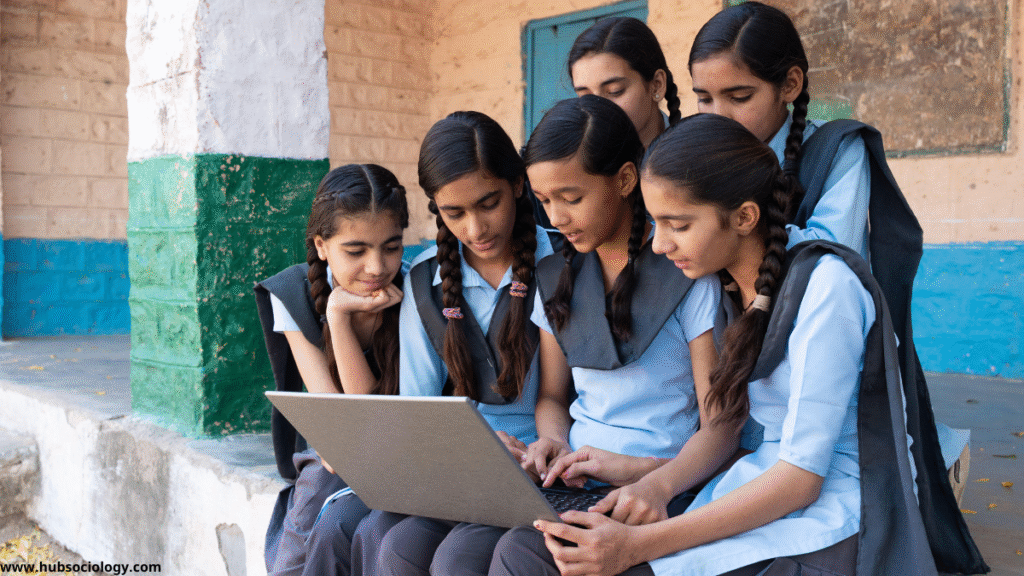Introduction on Digital Divide in India
In the 21st century, access to digital technologies has become as vital as access to education, health care, or economic opportunities. The “digital divide” refers to the gap between individuals, groups, or regions that have access to Information and Communication Technologies (ICTs)—computers, internet, mobile phones, broadband—and those who do not. This divide is not only about physical access but also about affordability, quality of connectivity, and the skills to use technology effectively.
In India, a country marked by sharp social stratification along lines of caste, class, gender, and region, the digital divide reflects and reinforces existing inequalities. While the government promotes the vision of Digital India, the benefits of technological growth are unevenly distributed. A sociological exploration of the digital divide allows us to see how technology interacts with structures of inequality, power, and social change.
Understanding the Digital Divide
Sociologists view the digital divide not as a purely technological issue but as a social problem linked to inequality. It is not simply about “who has internet” and “who does not.” Instead, it involves:
- Access Divide – disparity in owning devices and having internet connectivity.
- Usage Divide – differences in digital literacy and ability to use ICT meaningfully.
- Quality Divide – gaps in speed, affordability, and reliability of digital services.
Thus, the digital divide mirrors larger social inequalities, often determined by income, education, gender, caste, and geography.

Historical Context and Global Comparisons
Like the Industrial Revolution that once divided the world between industrialized and non-industrial societies, the ICT revolution has created new winners and losers. Globally, developed countries were the first to adopt digital technologies, while developing countries struggled to keep pace. Within nations, metropolitan centers thrive with high-speed networks while remote areas lag behind.
India’s digital divide is particularly stark because of its vast rural population, economic disparities, and complex social hierarchy. Compared to countries like China, where regional imbalances also exist, India’s challenges are compounded by caste and gender-based exclusion.
Dimensions of Digital Divide in India
1. Rural–Urban Divide
Urban India enjoys far greater internet penetration than rural areas. Cities have better infrastructure, electricity, and telecommunication facilities, whereas rural villages often lack even basic connectivity. This prevents rural populations from accessing online education, digital markets, and e-governance services.
2. Class Divide
Economic inequality is a key driver of the digital divide. Internet-enabled devices and broadband services require purchasing power. Wealthier households in cities are more likely to use smartphones, laptops, and high-speed internet, while the poor struggle with basic connectivity.
3. Caste and Community Divide
Marginalized communities such as Dalits, Adivasis, and other backward classes often live in areas with weak infrastructure and limited digital services. Social discrimination compounds the lack of access, reinforcing exclusion in education and employment opportunities that depend on ICT.
4. Gender Divide
Women in India face double disadvantages—patriarchal restrictions and economic barriers. According to various surveys, fewer women own mobile phones or have independent internet access compared to men. Even when access is available, cultural norms often restrict women’s online participation.
5. Generational Divide
Young people, especially in urban areas, are more digitally active compared to the elderly. Older generations often lack digital literacy, making them dependent on younger family members for online tasks such as banking or government services.
Sociological Theories and Perspectives

Knowledge as Power
Daniel Bell’s idea of the “post-industrial society” suggests that information and knowledge are new forms of wealth. In India, those with digital access enjoy significant advantages in education, employment, and social mobility.
Habermas and the Public Sphere
Jurgen Habermas worried about the shrinking of the public sphere due to privatization of information. In India, while digital platforms provide space for democratic participation, unequal access means that only certain voices dominate online discourse, sidelining marginalized groups.
Castells’ Network Society
Manuel Castells argues that modern society is shaped by networks of information. In India, metropolitan cities have become hubs of the digital economy, attracting skilled professionals, while rural areas remain excluded. This uneven integration deepens social inequality.
Marxist Perspective
From a Marxist lens, the digital divide reflects the capitalist control over technology. Big corporations and elites benefit from the expansion of ICT, while the poor remain consumers with little say in how technology is shaped or distributed.
Consequences of the Digital Divide
- Educational Inequality – Online learning opportunities favor students from urban, middle-class families with digital access. The COVID-19 pandemic revealed this starkly when millions of rural and poor students were left out of online classes.
- Economic Exclusion – E-commerce, online banking, and digital jobs benefit those with access, while the poor remain confined to informal labor.
- Political Disempowerment – Digital governance initiatives assume access to the internet. Those without connectivity cannot easily avail welfare schemes or register grievances.
- Cultural Marginalization – English dominates digital content, alienating non-English speaking populations. Although regional language content is growing, it remains limited.
Digital Inclusive Policies in India
Recognizing the challenge, the Indian government has introduced several initiatives:
- Digital India Mission (2015) – aims to transform India into a digitally empowered society through e-governance, broadband highways, and digital literacy.
- Bhoomi Project (Karnataka) – digitization of land records to reduce bureaucratic corruption.
- Gyandoot (Madhya Pradesh) – rural information kiosks providing farmers with data on crops, prices, and services.
- e-Seva (Andhra Pradesh) – online access to government services and tax payments.
- FRIENDS Project (Kerala) – centralized counters for tax and utility payments.
- PMGDISHA (Pradhan Mantri Gramin Digital Saksharta Abhiyan) – launched to make 60 million rural households digitally literate.
These programs show the potential of ICT to reduce inequality, but their success depends on addressing deeper issues of poverty, gender bias, and infrastructural gaps.
Bridging the Digital Divide: A Sociological Approach
To narrow the digital divide, policies must go beyond technological supply and address the social context:
- Affordable Access – Subsidized internet and low-cost devices for poor households.
- Digital Literacy – Training programs in schools, community centers, and rural libraries to enhance usage skills.
- Gender Inclusion – Special schemes for women to own and control mobile devices.
- Regional Development – Investment in rural broadband infrastructure to reduce urban–rural disparities.
- Local Content Creation – Encouraging digital platforms in Indian languages to ensure inclusivity.
- Community Participation – Involving local bodies, NGOs, and citizens in ICT projects to ensure relevance and accountability.
Conclusion on Digital Divide in India
The digital divide in India is not merely about technology—it is a reflection of social inequality. Access to ICT is now as fundamental as access to education or healthcare, and without it, marginalized groups risk being left further behind. From a sociological perspective, the digital divide reinforces existing divisions of class, caste, gender, and region.

Bridging this divide requires more than ambitious government projects; it demands inclusive policies that empower the poor, women, and rural communities. Only by viewing digital access as a matter of social justice rather than a luxury can India truly become a digitally empowered society.
Do you like this this Article ? You Can follow as on :-
Facebook – https://www.facebook.com/hubsociology
Whatsapp Channel – https://whatsapp.com/channel/0029Vb6D8vGKWEKpJpu5QP0O
Gmail – hubsociology@gmail.com
Exam-style questions on Digital Divide in India
5 Marks Questions on Digital Divide in India (Short Answer)
- Define the term digital divide in a sociological sense.
- Mention two major dimensions of the digital divide in India.
- How does gender contribute to the digital divide in India?
- State one consequence of the digital divide during the COVID-19 pandemic.
- Name two government projects that aim to reduce the digital divide in India.
10 Marks Questions on Digital Divide in India (Medium Answer)
- Discuss the rural–urban divide in digital access in India with examples.
- Explain how caste and class inequalities shape the digital divide in Indian society.
- What are the major consequences of the digital divide on education and economy?
- Critically analyze the role of Digital India Mission in bridging the digital divide.
- Using Habermas’ concept of the public sphere, explain how unequal access to the internet influences democratic participation in India.
15 Marks Questions on Digital Divide in India (Long Answer/Essay Type)
- Examine the digital divide in India through the lens of sociological theories such as Daniel Bell’s post-industrial society, Castells’ network society, and Marxist perspectives.
- “The digital divide in India reflects and reinforces existing inequalities of class, caste, gender, and region.” Discuss with suitable examples.
- Evaluate the effectiveness of government initiatives like Bhoomi, Gyandoot, FRIENDS, and PMGDISHA in reducing the digital divide. What challenges remain?
- Analyze the consequences of the digital divide for Indian society in terms of education, economy, politics, and culture.
- Suggest sociological strategies for bridging the digital divide in India. How can policies be made more inclusive?
